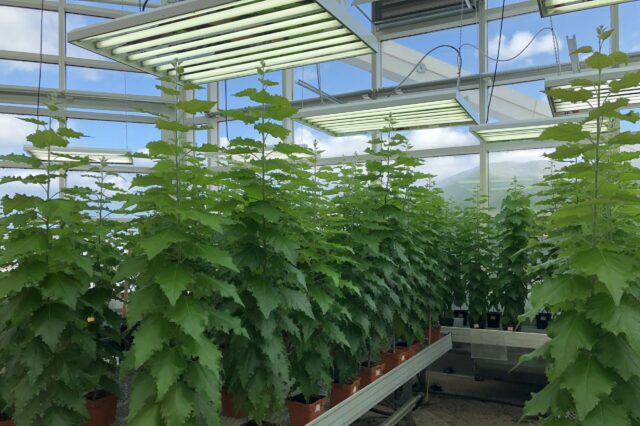
Genetic modifications to these poplar trees made it easier to extract sugars for fermentation into ethanol. Credit: Shekhar Joshi, Michigan Technological University
Scientists collaborating through the Center for Bioenergy Innovation (CBI) have found that small modifications to a single gene can improve the potential for producing ethanol from poplar trees.
Researchers wanted to understand how a gene called KNAT7, which had been studied previously in cress and tobacco, affects cell wall composition and behavior in poplar. The species has promise as an affordable and versatile feedstock for making biofuel.
Scientists at Michigan Technological University experimented in three ways with altering the plant’s secondary cell walls. First, they boosted the gene’s effect on the part of the cell walls that transports water and nutrients. With another group of cells, they decreased the effect. In a third group, they used KNAT7 from another plant, Arabidopsis, in some of the poplar cells, according to principal investigator Shekhar Joshi. He is chair of the Biological Sciences Department at Michigan Tech.
Trees were grown from each of these three genetically altered poplar strains. Researcher Liz Ware at the National Renewable Energy Laboratory analyzed their cell wall composition. Research scientist Ajaya Biswal at the University of Georgia fed the biomass to enzymes, analyzing how easily the sugars could be released for fermentation into ethanol.
The results were surprising in several ways.
Joshi said he had expected the under-expressed gene to perform much better than the others. Instead, “there were some minor differences, but all three gave good sugar release,” he said. None harmed plant growth or yield, either.
The experiments also had an unexpected outcome related to lignin, which provides strength and stiffness to cell walls in woody plants. Researchers observed that KNAT7 affected the composition of the lignin without always reducing the amount, Ware said.
“When we saw the sugars were easier to get out, we expected to see less lignin,” she explained. The reason why that correlation did not occur is unclear and invites further research, she said.
“Understanding the structural architecture of cell walls will help us better understand the characteristics we saw,” Ware said. “We know the cell wall is made up of different polymers. But just because we know what they’re made of doesn’t necessarily help us understand how to break them down. For example, you may know a house is made of sticks and stones and mortar. But you still need to know how all those pieces fit together to make it structurally sound. You can’t just throw a bunch of sticks in a pile and call it a house.”
Joshi said his team’s use of slight genetic alterations was different from the more conventional approach, which essentially turns a gene off or on completely. Such big conventional changes create more potential for undesirable effects on plant health and growth—for example, leaving plants floppy, disease-prone, or stunted. The changes made to KNAT7 were more subtle, targeting select functions and only during certain stages, Joshi said. Still, these tiny tweaks had a big effect on the plant’s potential as a feedstock.
Joshi said he looks forward to applying this strategy to other genes in the same family and measuring the results. Some of these genes may work together and changing both could improve performance even more.
Ware agreed that the study results provide scientists with more options. “We now have a better understanding of the role KNAT7 plays in secondary cell formation in poplar, and we can use that as a tool for designing an optimized feedstock for fuels and other products,” she said.
That’s important because poplar is potentially a good feedstock: it grows quickly, regrows easily when harvested, and exhibits a lot of genetic variation. Importantly, scientists have access to a database that includes 28 million genetic variations across the poplar genome—a resource created by scientists at the BioEnergy Science Center, the precursor to CBI.
CBI at Oak Ridge National Laboratory is one of four Department of Energy Bioenergy Research Centers focused on advancing biofuels and bioproducts for a vibrant domestic bioeconomy. CBI is accelerating the development of bioenergy-relevant plants and microbes to enable the production of drop-in sustainable aviation fuel, bioproducts that sequester carbon, and sustainable replacements for plastics and other environmentally harmful products. CBI research is supported by the Biological and Environmental Research program in DOE’s Office of Science.
